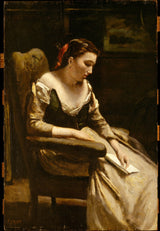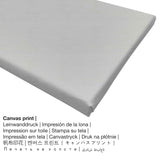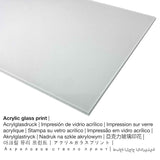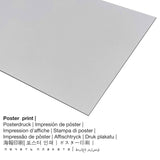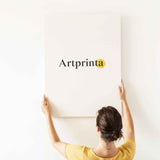Camille Corot, 1865 - Akwụkwọ ozi - mbipụta nka mara mma
Ụtụ gụnyere. Mbupu gbakọrọ na ndenye ọpụpụ.
Background information on this artpiece from the modern artist Camille Corot
The nkà nke oge a onye na-ese ihe na-ese ihe osise Camille Corot. The over 150 year-old original has the size 21 1/2 x 14 1/4 in (54,6 x 36,2 cm) and was crafted with the Usoro of mmanụ n'elu osisi. N'oge a, artpiece dị na nchịkọta nka dijitalụ nke Museumlọ ihe ngosi nka nke Obodo. a nkà nke oge a masterpiece, nke bụ nke ngalaba ọha a na-enye ya site n'ikike nke Ụlọ ihe ngosi nka nke Metropolitan, New York, HO Havemeyer mkpokọta, Onyinye nke Horace Havemeyer, 1929. Ebe kredit nke ọrụ nka: Nchịkọta HO Havemeyer, Onyinye nke Horace Havemeyer, 1929. E wezụga nke a, nhazi ahụ dị na eserese format ya na oke nke 1: 1.4, nke pụtara na ogologo bụ 29% mkpụmkpụ karịa obosara. Camille Corot was a painter from France, whose art style can mainly be classified as Realism. The Realist painter was born in the year 1796 and died at the age of 79 in the year 1875.
Ozi izugbe sitere na webụsaịtị ihe ngosi nka (© Nwebiisinka - The Metropolitan Museum of Art - Museumlọ ihe ngosi nka nke Obodo)
This work owes much of its character to the precedent of the eighteenth-century French painter Chardin. Yet the motif and handling also reflect an awareness of seventeenth-century Dutch painting, particularly Vermeer and de Hooch, whose works Corot could have seen during a trip to Holland in 1854. This picture was probably painted around the time Vermeer’s art was enjoying a revival of interest.
Ozi ndabere gbasara nka
| Akụkụ nka: | "Akwụkwọ Ozi" |
| Nhazi: | sere |
| Okwu nche anwụ: | nkà nke oge a |
| oge: | 19th narị afọ |
| Emepụtara n'afọ: | 1865 |
| Afọ nka: | ihe dị ka afọ 150 |
| Usoro nka izizi: | mmanụ n'elu osisi |
| Akụkụ izizi (ọrụ nka): | 21 1/2 x 14 1/4 na (54,6 x 36,2 cm) |
| Ụlọ ihe ngosi nka / ebe: | Museumlọ ihe ngosi nka nke Obodo |
| Ebe ngosi nka: | New York City, New York, Njikota Obodo Amerika |
| Webụsaịtị ihe ngosi nka: | Museumlọ ihe ngosi nka nke Obodo |
| Ikikere nke ihe osise: | ngalaba ọha |
| Site n'aka: | Ụlọ ihe ngosi nka nke Metropolitan, New York, HO Havemeyer mkpokọta, Onyinye nke Horace Havemeyer, 1929 |
| kreditline ọrụ nka: | Nchịkọta HO Havemeyer, Onyinye nke Horace Havemeyer, 1929 |
Tebụl nyocha nke onye na-ese ihe
| Ihe nkiri: | Camille Corot |
| okike nke onye nka: | nwoke |
| Nationality: | French |
| Ọrụ nke onye na-ese ihe: | onye na-ese ihe |
| Country: | France |
| Otu nka: | omenkà nke oge a |
| Ụdị nke onye na-ese ihe: | Ihe ngosi |
| Nwụrụ na afọ nke: | 79 afọ |
| Afọ ọmụmụ: | 1796 |
| Nwụrụ n'afọ: | 1875 |
Họrọ ihe kacha amasị gị
The product dropdown menu gives you the chance to select the size and material of your choice. You can choose among the following product customization options:
- Mbipụta enyo acrylic: An acrylic glass print, often named a UV print on plexiglass, will convert your favorite original artwork into beautiful décor and offers a good alternative to canvas or dibond art prints. The great upside of a plexiglass art print is that contrasts as well as small painting details will be exposed thanks to the subtle tonal gradation. Our plexiglass protects your custom art replica against sunlight and heat for many decades.
- Mbipụta kanvas: The printed canvas material applied on a wooden frame. Hanging a canvas print: Canvas prints are relatively low in weight, meaning that it is easy to hang up your Canvas print without the help of additional wall-mounts. That is why, a canvas print is suitable for any kind of wall.
- Aluminom dibond (ọkpụkpụ ọla): An Aluminium Dibond print is a print with a true depth - for a modern look and a non-reflective surface. The Direct Print on Aluminum Dibond is the excellent introduction to reproductions with aluminum. The white & bright components of the original artpiece shimmer with a silk gloss but without any glow.
- Mbipụta akwụkwọ mmado (ihe kwaaji): Our poster print is a printed sheet of flat canvas paper with a slightly roughened texture on the surface, which reminds the actual version of the artwork. Please note, that depending on the absolute size of the canvas poster print we add a white margin of something between 2 - 6cm round about the print motif in order to facilitate the framing with your custom frame.
Ngwaahịa a
| Ụdị edemede: | ọrụ mgbidi |
| Usoro mmeghari: | dijitalụ mmeputakwa |
| Production usoro: | mbipụta dijitalụ (Mbipụta UV ozugbo) |
| Nlụpụta: | arụpụtara na Germany |
| Ụdị ngwaahịa: | na mmepụta ihe |
| Ngwaahịa were: | nchịkọta nka (mmeputakwa), mma mgbidi |
| Ndepụta: | nhazi ihe osise |
| Njikwa oyiyi: | 1: 1.4 |
| Ntụgharị nkọwa akụkụ onyonyo: | ogologo bụ 29% mkpụmkpụ karịa obosara |
| Akwa mmeputakwa dị: | acrylic glass print (nwere ezigbo mkpuchi iko), mbipụta akwụkwọ mmado (akwụkwọ kwaaji), mbipụta kanvas, mbipụta ọla (aluminium dibond) |
| Mpempe akwa akwa (akwa akwa na etiti ihe ndọtị) nha: | 50x70cm - 20x28", 100x140cm - 39x55" |
| Mbipụta iko acrylic (nwere ezigbo mkpuchi iko) dị iche iche: | 50x70cm - 20x28", 100x140cm - 39x55" |
| Mpempe akwụkwọ mmado (akwụkwọ kwaaji) nha: | 50x70cm - 20x28" |
| Ụdị nha ebipụta aluminom: | 50x70cm - 20x28", 100x140cm - 39x55" |
| ụba: | biko buru n'uche na emeghi ka mmeputakwa a |
Legal note: We try what we can to depict our art products as accurate as it is possible and to illustrate them visually on the product detail pages. Please keep in mind that the pigments of the printing material and the printing may vary marginally from the image on your screen. Depending on your screen settings and the condition of the surface, colors can unfortunately not be printed as exactly as the digital version on this website. Because all art prints are printed and processed manually, there may as well be minor differences in the exact position and the size of the motif.
© Nchekwa ikike nwebisiinka - Artprinta (www.artprinta.com)

